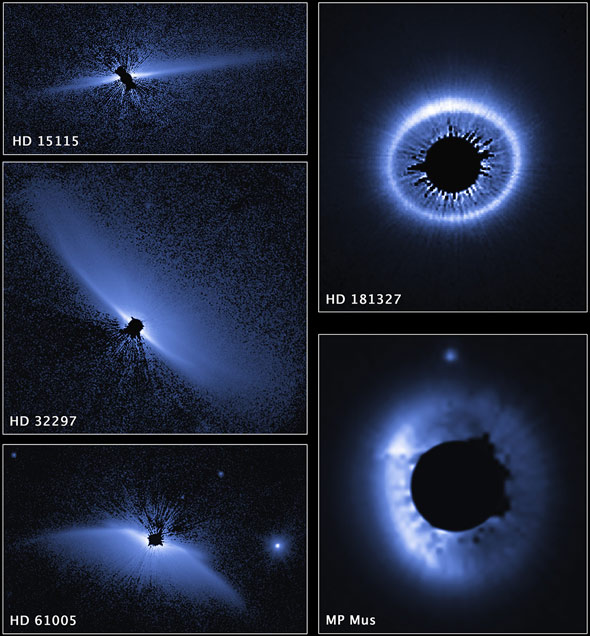Create a free profile to get unlimited access to exclusive videos, sweepstakes, and more!
When Worlds Collide, Rings Follow

A few days ago I posted a spectacular picture of a protoplanetary disk, a sprawling multiringed wheel of gas and dust swirling around a young, nearby star. I mentioned I had studied such objects before; it all started in the late 1990s when I was working on a Hubble Space Telescope camera called the Space Telescope Imaging Spectrograph, or STIS. An astronomer named Carol Grady had observed several such disks around stars, and I helped calibrate and process the images.
And by coincidence, new Hubble images of several similar structures were just released … taken by STIS!
Quite the menagerie. Each image shows a ring around a different star, and the fierce light of the stars themselves has been blocked out so it doesn’t blow out the much fainter light from the rings.
However, unlike the disk image I wrote about last week, these are not protoplanetary disks. They’re dusty debris remnants, shaped more like rings than disks, probably caused by collisions of asteroids and/or comets (some of them quite large) orbiting these stars after planetary formation has already been well underway. In other words, these are somewhat older structures from 100 to 350 light-years away.
What’s striking are the weird shapes. You might expect they’d be circular, symmetric, and flat. But they are anything but! The ring seen edge-on around HD 32297 appears to flare, like wings, as does the one around HD 61005. My first thought was that they’re moving through space, plowing through the thin material between the stars. That would blow the rings back a bit, warping them. The analysis done by the team that took the images agrees.
I was also struck by the asymmetry in the ring around HD 181327. Elliptical rings are usually actually circular, but we see them at an angle (like the rim of a drinking glass can look like an oval). But this ring is distorted, thicker and brighter on one side. If it’s from the collision of two objects, they must have been pretty large, and what’s left of the two bodies is probably in that larger, thicker part, with the debris having spread out around the star. The ring is about 13 billion kilometers in radius (about three times the distance of Neptune to the Sun), which is pretty weird: You’d think space would be fairly empty that far from the star, and collisions rare. But there it is.
Interestingly, the inner edge of the ring is pretty sharp, when it would be expected to be fuzzy. That means there may be a planet too faint to see in these images, orbiting inside the ring, and gravitationally clearing out the debris closer to the star.
Clearly, other young solar systems have all sorts of behavior problems, and no two appear to be exactly alike. While that makes them somewhat harder to study (it’s nice to be able to categorize objects using similar characteristics), it also makes this more exciting. Surprises are always fun.
And it pleases me greatly to know that not only were these observations made using my old camera, but they were also taken by my old friends Glenn Schneider and the aforementioned Carol Grady, along with a handful of other astronomers with whom I worked in my Hubble days. It’s nice to see good scientists still doing good work.














